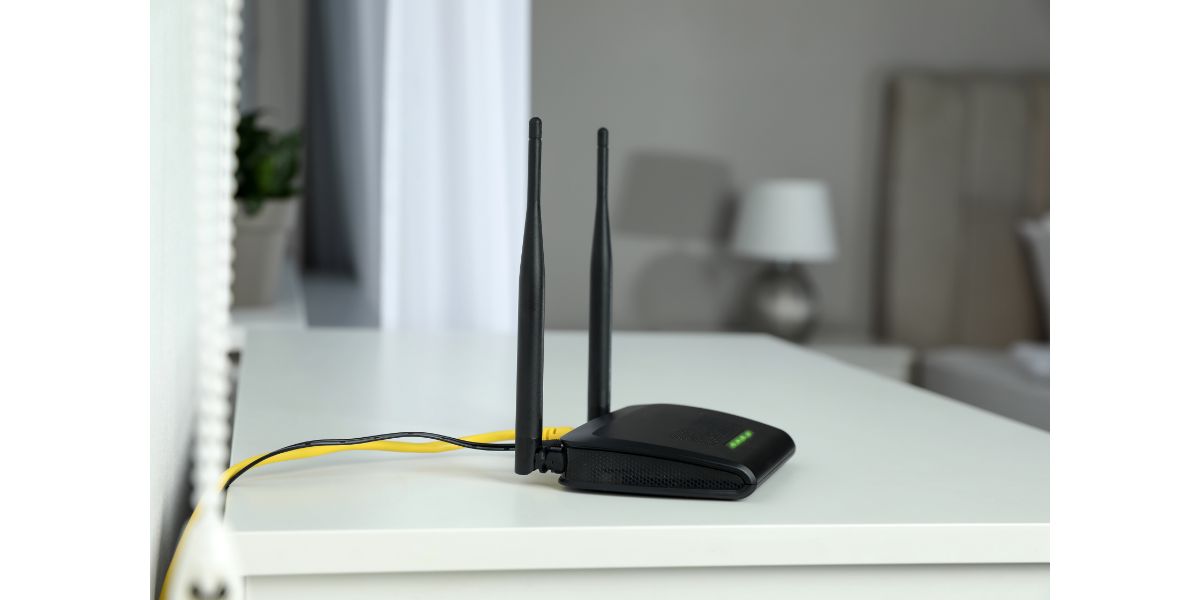Disclaimer: This post may contain affiliate links, meaning we get a small commission if you make a purchase through our links, at no cost to you. For more information, please visit our Disclaimer Page.
WiFi routers are known to generate electromagnetic fields, which produce small amounts of non-ionizing radiation. Therefore, in general, it is not recommended to sleep near wireless routers. It’s best to move routers, use blockers, or turn them off at night.
Table of Contents
The Dangers of Sleeping Next to a Router
The main danger of sleeping next to a WiFi router is exposure to electromagnetic field (EMF) radiation. Exposure to radiation has been linked to possible health risks, although more research is needed to determine the bio-hazards of consistent exposure to WiFi radiation.
The potential health risks of exposure to EMFs are a growing concern for many people. If you are concerned about EMF exposure, it’s best to take precautionary measures such as keeping WiFi routers away from your bed or switching them off at night.
Doing so can help reduce the amount of radiation reaching your body while you sleep or relax.
What Signals Does a WiFi Router Emit?
WiFi routers emit radio frequencies that exist at a specific wavelength optimal for communication. These electromagnetic signals are higher than audio frequencies and lower than microwave frequencies and are generally within 30 MHz – 300 GHz.
While radio frequencies are efficient for transferring data at high speeds, such as your internet connection, they produce a small amount of radiation as a byproduct.
WiFi routers produce non-ionizing radiation (NIR), which lacks the energy to place a charge (ionize) on atoms. This radiation is relatively harmless, but it can become detrimental in large doses.
Are These Signals Really Harmful?
The World Health Organization (WHO) recognizes non-ionizing EMF radiation as a Group 2B carcinogen. This classification indicates that EMF radiation can potentially cause cancer through oxidative stress and DNA damage but lacks the scientific evidence to be known as a cancer-causing agent.
While scientific evidence of the carcinogenic effects of EMF radiation is limited, routers may carry potential risks for those who spend time near them.
Can WiFi Routers Affect Sleep?
The radiation from WiFi routers can inhibit sleep by reducing melatonin production. Melatonin is essential for signaling that the body is ready for sleep and meets its circadian rhythm.
To evaluate the effects of extremely low-frequency non-ionizing radiation, such as that produced by routers, scientists measured the effects of this radiation on melatonin production.
They found that NIR reduced melatonin production significantly in exposed cells. Reduced melatonin can cause a lack of sleep, leading to brain fog, depression, and overall fatigue.
Additionally, many routers have a blue light that indicates they are on and working adequately. Exposure to blue light before or during sleep will also inhibit melatonin production and interfere with your sleep cycle.
Can WiFi Radiation Cause Cancer?
Sleeping near a router exposes you to non-ionizing radiation. This type of radiation is harmless in small doses and is not considered detrimental in most situations.
However, prolonged exposure to any radiation, even relatively mild NIR, can lead to carcinogenic effects. Since EMF is classified as a group 2B carcinogen, there is a possibility that enough exposure to router radiation can lead to cancer.
Because the average American sleeps about 6 to 8 hours each night, sleeping next to a WiFi router will necessarily expose individuals to large doses of NIR.
What Is EMF Exposure?
EMF exposure is the prolonged adverse effects of spending significant time near non-ionizing electromagnetic fields.
While non-ionizing radiation is relatively safe, it can still cause health issues in long enough doses. These issues are similar to exposure to ionizing radiation, such as radon, but take much more time to develop and are much less severe.
Further, there is no evidence that EMF exposure is permanent or life-threatening, and individuals report their symptoms going away once the EMF source is removed.
Symptoms of EMF Exposure
While there is limited scientific evidence on the health effects of EMF exposure, there are many anecdotal reports of side effects. After being exposed to EMFs, people often report feeling short-term effects such as headaches, fatigue, and difficulty sleeping.
Chronic symptoms may include muscle pain and joint stiffness. Some also note depression or anxiety-like symptoms that occur after prolonged exposure to devices with high levels of EMFs.
Other symptoms and side effects include:
- Head fogginess
- Tinnitus
- Nausea
- Rashes or eczema
- Heart palpitations or arrhythmias
Some people may have electromagnetic hypersensitivity (EHS), characterized by rapid symptoms in the presence of EMF radiation. These symptoms are generally physical, severely affecting the skin and respiratory system.
Examining these reported symptoms has yielded inconclusive results about the potential health risks associated with EMF exposure. Additionally, these effects vary widely between individuals and are influenced by many other factors, such as your sleep schedule and the distance of the router from your bed.
Regardless of the severity of your symptoms, prolonged exposure to any radiation is not considered beneficial to your health, and there are several ways to limit EMF exposure from your WiFi router.
How To Limit EMF Exposure in Your Bedroom
While your WiFi router may not be causing you any apparent distress, there’s no way to know what the prolonged effects of EMF exposure will have on your health.
The best practice is to limit EMF exposure to remove the possibility of EMF exposure and unintended side effects. Doing so is straightforward and may benefit your health for years to come.
Here are four ways to limit EMF exposure while you sleep.
1. Change the Router’s Location
The most straightforward step is to change your router’s location to another room in your residence. The best sites for routers are centrally located, near your electronic devices, and free of impenetrable obstructions.
This location will provide the best internet signal for your home and ideally be away from your bedroom. Additionally, you should avoid having a router in the kitchen where it can interfere with microwaves, another time of NIR.
Sometimes, the bedroom is your router’s strongest or most convenient location. In these situations, you can limit the power of the signal.
2. Use a WiFi Blocker
You can use a blocker to directly intercept WiFi signals from your router. WiFi blockers create an opposite EMF facing the router that cancels out its frequencies.
These devices are a type of portable radio jammer that are often used to prevent others from accessing your WiFi but can also limit EMF exposure during sleep.
3. Use a Faraday Cage
Faraday cages are another home solution specifically designed to block EMF radiation while you sleep. Also known as EMF protection canopies, they go around your bed and stop any EMF signals from affecting your circadian rhythm.
These devices are made of silver and are quite expensive. However, they remain one of the most efficient EMF blockers available during sleep.
4. Turn Off the Router
The most direct way to block WiFi signals is to turn them off at their source. Unplugging or powering down your router while you’re asleep is a quick and simple solution when EMF blockers aren’t available.
In some situations, such as with roommates who stay up late using the internet, this solution isn’t as practical, and a WiFi blocker may be more appropriate.
Final Thoughts
The radiation produced by WiFi routers, while relatively harmless, can become detrimental to health in prolonged doses, such as during sleep. If sleeping next to the router is inevitable, you can block the signal or turn the router off while you sleep.


